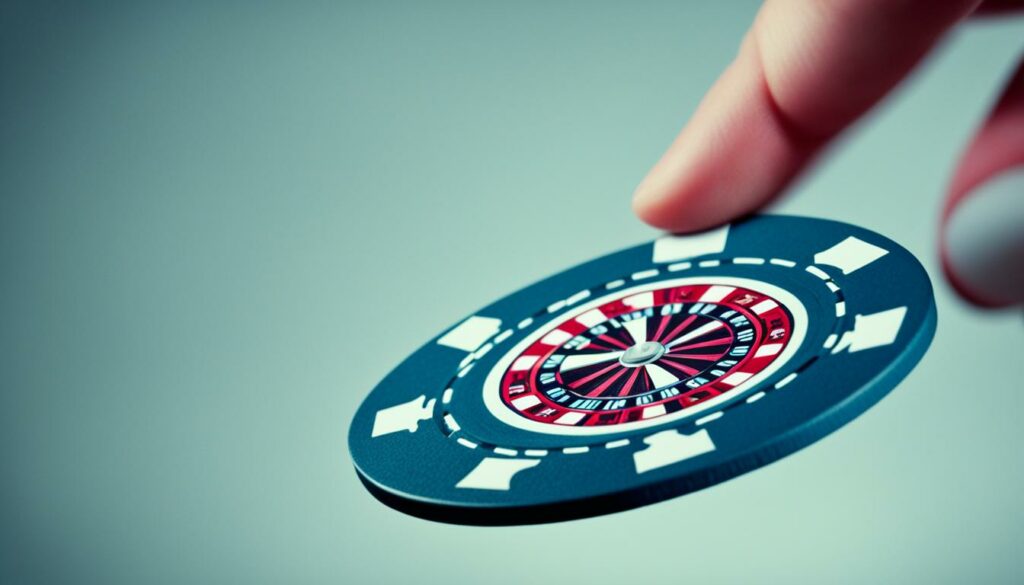Welcome to our comprehensive guide on mastering poker chip play. Whether you’re a novice or an experienced player, understanding how to play poker with chips is crucial for success at the table. In this guide, we will walk you through the essential strategies, techniques, and best practices for utilizing poker chips effectively.
Playing with poker chips involves more than just placing bets. It’s a skill that can greatly impact your gameplay and overall experience. By mastering poker chip strategies, you’ll be able to make calculated bets, maintain consistent chip stacks, and even impress your opponents with mesmerizing chip tricks.
In Section 2, we’ll delve into the world of poker chips, discussing their values, stacks, and effective stacking techniques. Understanding the different chip denominations and stacking methods will lay a solid foundation for your poker chip play.
Section 3 will focus on poker chip strategies that will elevate your gameplay. From making strategic bets to utilizing chips to your advantage, you’ll learn the best practices to play with confidence and increase your chances of winning.
No poker game is complete without some flair. In Section 4, we’ll explore various poker chip tricks that will not only entertain your opponents but also showcase your skill and mastery. From shuffling to knuckle rolling, these tricks will add an extra level of excitement to your poker sessions.
By following our step-by-step guide and practicing the strategies, techniques, and tricks discussed, you’ll become a master at poker chip play. So get ready to raise the stakes, outsmart your opponents, and enjoy the thrilling world of poker with chips.
Understanding Poker Chips: Values and Stacks
Before you can become a master at poker chip techniques and mastering poker chips, it’s crucial to have a solid understanding of poker chip values and stacks. In this section, we will delve into the world of poker chips, exploring their denominations, values, and effective stacking techniques that will enhance your gameplay experience.
Poker Chip Values
Poker chips come in various denominations, each representing a specific value. Understanding these values is essential for making informed bets and maintaining a consistent chip stack.
| Chip Color | Denomination |
|---|---|
| White | $1 |
| Red | $5 |
| Green | $25 |
| Blue | $50 |
| Black | $100 |
| Purple | $500 |
These are just a few examples of common chip denominations. Casinos and poker rooms often have their own unique chip colors and values, so it’s crucial to familiarize yourself with the specific chips in play before sitting at a table.
Poker Chip Stacks
Stacking your poker chips properly not only adds order to the game but also makes it easier to manage your bets and calculate winnings. Here are some effective stacking techniques to consider:
- Uniform Stacking: Place each chip on top of another, ensuring they are aligned and neatly stacked. This technique is straightforward and allows for easy chip counting.
- Color Segmentation: Group chips of the same color together to create visual segments in your stack. This helps in quickly identifying the value of your stack at a glance.
- Progressive Stacking: Begin with higher denomination chips at the bottom of your stack and stack chips of lower value on top. This technique keeps your higher-value chips secure and easily accessible for larger bets.
- Bottom Chip Placement: When stacking chips, place the heaviest or highest denomination chip at the bottom to provide stability to your stack.
Mastering poker chips involves not only understanding their values but also perfecting your stacking techniques. By adopting these strategies, you’ll be well-prepared to handle chips with confidence during your poker games.
Now that you’re armed with knowledge about poker chip values and stacks, let’s explore the strategies and best practices for utilizing these chips to their full potential. In the next section, we will cover essential poker chip strategies that will take your gameplay to the next level.
Baccarat’s Losing Streak: Unraveling the Odds of 10 Consecutive Losses
Poker Chip Strategies: Playing With Confidence
When it comes to excelling in poker, having effective chip strategies is essential. In this section, we will explore some of the best practices for poker chips that will enhance your gameplay and give you the edge over your opponents.
Maintain a Consistent Chip Stack
A consistent chip stack is crucial for a successful poker game. By maintaining a balanced chip stack, you can exert control over the game and make strategic decisions with confidence. Avoid becoming too top-heavy or having a dwindling stack, as it can limit the range of your bets and potentially expose your hand. A well-managed chip stack allows you to adapt to different situations effectively.
Utilize Chips for Betting Strategies
Your chip stack provides valuable information to your opponents. Utilize this insight to your advantage during betting. Placing well-calculated bets with different chip denominations can communicate a certain level of confidence or uncertainty about your hand. By strategically using your chips, you can manipulate the perception of your opponents and influence their decision-making process.
“In poker, your chips are your weapons. Knowing how to use them strategically can be the difference between winning and losing.”
Become Skilled in Chip Handling
Mastering proper chip handling is not only visually appealing but can also instill an air of confidence at the poker table. Developing techniques such as chip shuffling, flipping, and knuckle rolling adds an extra level of sophistication to your gameplay. These skills not only impress your opponents but also create an aura of competence that can work to your advantage throughout the game.
Make Quick and Decisive Chip Actions
Timing is key in poker, and the same applies to chip actions. Practice making quick and decisive chip movements to maintain control and keep the game flowing smoothly. Whether it’s making a bet, a raise, or a call, executing these actions confidently and efficiently can influence the dynamics of the game and keep your opponents on their toes.
Know When to Cash In
Finally, understanding when to cash in your chips is crucial. It’s important to recognize when it’s time to leave the table with your winnings and avoid chasing losses. A disciplined approach to cashing in your chips will help you maintain a positive mindset and protect your bankroll in the long run.

| Key Strategies | Benefits |
|---|---|
| Consistent chip stack management | Control over the game and better decision-making |
| Strategic use of chip denominations | Manipulation of opponents’ perception and decision-making |
| Mastering chip handling techniques | Adds sophistication and confidence to your gameplay |
| Quick and decisive chip actions | Influences game dynamics and keeps opponents on their toes |
| Knowing when to cash in | Protects bankroll and promotes a positive mindset |
Mastering Poker Chip Tricks: Impress Your Opponents
Adding flair to your poker game, this section will delve into the world of poker chip tricks. Whether you’re a seasoned player looking to show off your skills or a beginner wanting to add some excitement to your gameplay, mastering poker chip tricks can help you leave a lasting impression on your opponents.
Below, we’ve compiled a list of popular poker chip tricks and provided tips on how to perform them like a pro:
- Shuffling: The art of shuffling poker chips is not only visually impressive but also a great way to keep your hands busy during the game. To shuffle chips, start with a stack in one hand and transfer small stacks into your other hand, seamlessly interweaving them between your fingers. Practice the motion until you can shuffle chips effortlessly.
- Flipping: Show off your dexterity by mastering chip flipping. This trick involves flipping a single chip in the air and catching it with the same hand. Start by using your thumb to flick the chip upwards and practice catching it smoothly.
- Knuckle Rolling: Knuckle rolling is a mesmerizing trick that requires precise finger movements. Start with a stack of chips, place it between your fingers, and let them roll over your knuckles one by one. This trick takes practice, so don’t get discouraged if you don’t nail it right away.
- Chip Twirl: Impress your opponents with the graceful chip twirl. Holding a chip between your thumb and index finger, make a circular motion with your wrist, causing the chip to spin around your fingers. With practice, you’ll be able to twirl multiple chips simultaneously.
Remember: Practice makes perfect when it comes to poker chip tricks. Dedicate some time outside of your gameplay to refine your skills, and don’t be afraid to experiment with different tricks to find the ones that suit you best.
Now that you have an overview of some of the most popular poker chip tricks, it’s time to start practicing. Incorporate these tricks into your gameplay strategy and watch as your opponents marvel at your chip-handling prowess. In the next section, we will provide additional tips and tricks to help you enhance your overall poker game.

Conclusion
By following this step-by-step guide, you are well-equipped to play poker with confidence and skillfully handle poker chips. The strategies, techniques, and tricks discussed in this guide will guide you on the path to becoming a master at poker chip play. Dedicate time and effort to practice these valuable insights, and with perseverance, you can elevate your game and fully enjoy the thrilling world of poker with chips.
Poker chip play is not just about the cards; it’s also about how you use your chips strategically. Understanding chip values, effective stacking techniques, and maintaining a consistent chip stack will give you a competitive edge at the poker table. Additionally, learning and mastering impressive chip tricks can add an extra flair to your gameplay, leaving a lasting impression on your opponents.
So, whether you’re a beginner looking to learn the fundamentals or an experienced player aiming to refine your skills, this guide has provided you with all the necessary tools to excel at poker chip play. Now, grab your chips, join a game, and let your newfound knowledge and abilities propel you to success!
